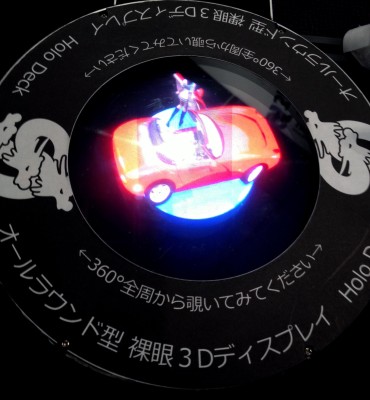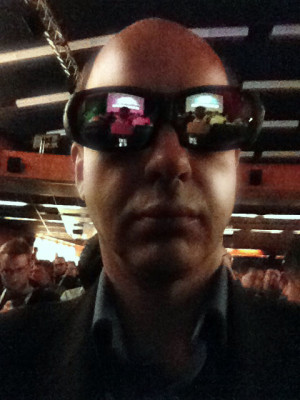The most exciting thing I saw was the Free Viewpoint TV (FTV) holodeck. Yes! The technology that introduced Princess Leia
to Luke Skywalker in1977 now exists in our own galaxy and can project holographic images right in front of you. I would say 3-D images but that term has been so badly abused and confused with stereoscopic that it seems unfair to use it for an image that you can you walk around. The screen was only the size of a dinner plate but I really could walk behind a projected object and see the back of it. It already has medical and industrial interest and I am told that there is technically no reason why the projector could not show motion pictures. In an interesting alternative use I was shown a face that animated as I walked around it as if I was walking through time. The truly holographic image uses a rig of about 30 cameras but the animated holograph was created using one camera in a motion control type shoot. It is the modern evolution of the Matrix bullet shot.
Closer to production and still a highlight was the Christie six primary laser projector with Dolby Atmos showing Dolby 3-D at 14 foot lamberts on the big screen. Dawn of the Planet of the Apes was projected on to a normal
white screen instead of a silver screen, which solves the common dilemma many cinemas have of using one screen but needing two. Apparently they still had to turn down the brightness of the lasers to keep it at the regulation 14ft lamberts. Nice problem to have. For the geeks the Christie output was over 50,000 lumens. Did it make a difference? Absolutely. Why six lasers? Because Dolby 3-D projects the left eye and the right eye images simultaneously but with a frequency offset, whereas other 3-D technologies typically project left eye and right eye sequentially. Dolby 3-D has the advantage that both eyes View the image at the same time just like in real life but it needs two projectors or 6 lasers. The result was certainly much more life like than anything I have seen before, especially the inevitable shots through windows. The brighter simultaneous stereo images without silver screen hotspots address many of the problems associated with stereoscopic grading. The Atmos sound coming from discrete speakers all around and above further enhanced the reality.
I was also lucky enough to see Dolby Vision with Baselight controlled mastering. This prototype monitor can push brightness in selective areas to 4000 nits. That’s significantly brighter than the 100 nits of rec. 709. The Baselight has a Dolby plug-in that maps the 4000 nit grade and converts it to a 100 nit grade. The colorist can then make scene-to-scene trims as required. From these two extremes the plug-in calculates values for screens at in between brightness levels, again with the ability to make trims. The adjustments and trims are stored as metadata so that a suitably equipped display can use trims that match its brightness contrast calibration. The intention is clearly to bring the benefit of brighter displays to consumers in the home.
Dolby Vision is described as high dynamic range (HDR). It is worth pointing out that there are two distinct angles to HDR. The first is that an image contains information in shadows and highlights, or in simple terms it does not clip. This is the challenge for cameras and scanners. HDR monitors take this detail and display it at increased brightness and contrast. The goal being to achieve levels that are closer to reality. Imagine an image of a flickering candle or a flame that emitted as much light as the real thing. Not only does the image look very real but it induces the perception of warmth as well.
BBC R&D also showed HDR monitoring using gamma and highlight profiles so that media can play back on both rec. 709 and HDR screens. It is worth noting that all the HDR displays are based on the same Sim2 technology as far as I can see. In the future zone 4ever showed HDR as well as high frame rate (HFR) and wide color gamut (WCG) solutions in preparation for UHD phase2. For HDR they have developed a plug-in that allows a colorist or viewer to use HDR display technology. Similarly they have developed an intelligent range of Luts that map rec. 709 to wider gamuts preserving the artistic intent by protecting skin tones and enhancing skies for example. They showed a selection of these Luts to achieve a variety of results that take advantage of increased colour space. Of course they also admitted that there is no way to view rec 2020 yet or indeed any standard for wide color gamut beyond P3. All eyes are on lasers and quantum dot technologies. The good news for colorists is that everything would need to be re-graded to take advantage of these HDR screens, no matter which technology prevail.
Also in the future zone the regular NHK 8K demonstration took place. They showed a large screen football match in UHD 8k-high frame rate. Certainly the motion and detail were impressive but this was really let down by the blown out whites of the team wearing white shirts and white pants. For me it was proof that dynamic range and greater bit depth are by far the most important aspect of resolution. In general UHD continued to be mentioned everywhere, although it annoyingly still means nothing more than 4k resolution. There is rarely any mention of higher frame rates, contrast or color gamut. Nevertheless everything from transcoders to scopes and storage to broadcast is advertising support.
BMD announced the acquisition of Eyeon who make Fusion software. Fusion is a much-respected high end VFX package used on films such as Sin City, Gravity and Spiderman. At sometime in the future we can probably expect compositing and effects features in Resolve. Nobody at BMD would confirm that, but Fusion is node based, runs on CUDA and supports .dng. so I am just doing the math here. The company are saying that resolve will continue to get edit upgrades and their ambitious intention is to compete with Adobe, Avid, Autodesk and Quantel to provide a complete postproduction service.
On a less positive note their restoration software Revival is end of life and was not on display. Which brings us on to the BMD Cintel scanner. It is still not shipping, but it is a sprocket driven field array scanner controlled from Resolve. Whilst I believe that field arrays are in principal better than line arrays, the sprocket drive is likely to limit this scanner to new film in good condition and the output is .dng only, meaning that it would likely need transcoding before use by most other systems. Perhaps this is a policy to further cement Resolve dominance in the market or maybe it is just simpler to make the scanner output the same as the BMD cameras, but the result is that the scanner is unlikely to be useful to the archive market. Since BMD is dropping their main restoration tool at the same time the archive market does not seem to be on the BMD radar. As you might expect the scanners most obvious feature is the cost at around $32,000 or a third of the price of its nearest rivals.
Resolve with Fusion might follow in the footsteps of SGO Mistika, which was demonstrating the use of CG mattes and metadata to separate individual CG elements and multiple alpha channels. In fact CG metadata could also be used to change CG lighting in the colour grade session. This is a result of developments for Peter Jackson on the Hobbit trilogy, and at the moment is only possible on CG content that has been exported complete with the necessary metadata. But it does set an interesting new bar for colour correctors and colorists.
Across the aisle from SGO was Digital Vision who were showing their excellent FilmMaster grading and DVO restoration tools. It is still my favourite system because it combines the best of both grading and restoration in one product range and it continues from strength to strength. The highlight on their booth was Thor, an accelerator card for DVO. Clarity is the market leader for motion estimated grain management and runs 4 frames per second in HD at best. The Thor card accelerates Clarity to 50 fps!
There continue to be low-cost scanners from MWA, Sondor and CTM, but my favourite by far is the Lasergraphics scan station. This desktop scanner now has a 5K option and can handle all formats from 8mm to 35mm with impressive digital steady and film density specs. It can also do pick ups after a film break using frame recognition and it outputs direct to file not video. That means it can happily run SD at 60 frames per second even with optical or magnetic sound. Optical is captured as an image so that it can be better processed afterwards.
In other news DPP continues to enable file based delivery to UK and many European broadcasters. At IBC they announced that Root6, Telestream, Cinegy and Dalet Amberfin have passed AMWA certification. The DPP are now working on plans for compliant storage of file based broadcast masters.
There were a lot of storage solutions, hardware and software based and a very heavy push towards cloud storage and services. I noted a bit of a trend towards offers of software as a service rather than a purchase, and the service usually relied on cloud storage for delivery in both directions. Nobody seemed concerned that I might have to move my data across 3 or more different clouds to get all the services I want, but I suppose that’s progress.
So there you have a glimpse of my IBC. The ICA Colorist Mixer event on Saturday night was a huge success and continued in the traditions of the TIG, showing that colorists remain as passionate as ever.
The future is bright – thanks to HDR monitors and laser projectors.
Happy Coloring!







